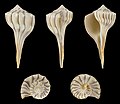| Sinistrofulgur perversum | |
|---|---|
 | |
| Sinistrofulgur perversum found in France, with the operculum in place | |
| Scientific classification | |
| Kingdom: | Animalia |
| Phylum: | Mollusca |
| Class: | Gastropoda |
| Subclass: | Caenogastropoda |
| Order: | Neogastropoda |
| Family: | Busyconidae |
| Genus: | Sinistrofulgur |
| Species: | S. perversum |
| Binomial name | |
| Sinistrofulgur perversum (Linnaeus, 1758) | |
 | |
| Range | |
| Synonyms | |
Sinistrofulgur perversum, the lightning whelk, is a species of very large predatory sea snail or whelk, a marine gastropod mollusc in the family Busyconidae, the busycon whelks. This species has a left-handed or sinistral shell. It eats mostly bivalves.
Contents
- Distribution
- Habitat
- Life habits
- Sinistrofulgur perversum and Busycon carica
- Human use
- Gallery
- References
- External links
There has been some disagreement about the correct scientific name for this species, which has been confused with Sinistrofulgur sinistrum Hollister, 1958, and Busycon contrarium (Conrad, 1840), which is an exclusively fossil species. [1] [2]
- Form with extensions
- Form without extensions





